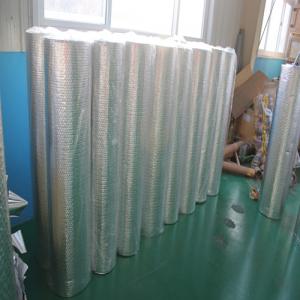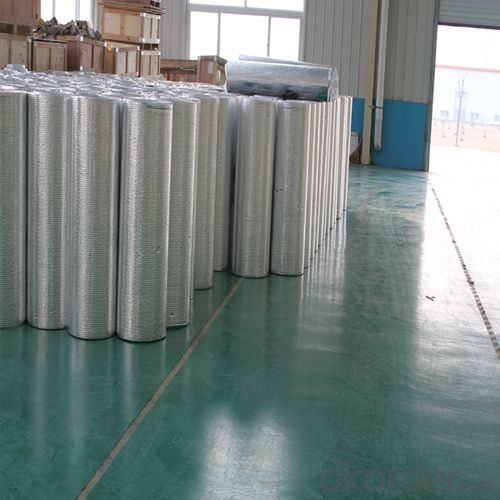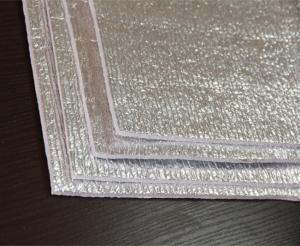4 Foot By 4 Foot Iso Roofing Insulation - Aluminum Foil and Polyester Bubble for Insulation
- Loading Port:
- Tianjin
- Payment Terms:
- TT or LC
- Min Order Qty:
- 10000 m²
- Supply Capability:
- 1000000 m²/month
OKorder Service Pledge
OKorder Financial Service
You Might Also Like
Aluminum Foil Bubble Heat Insulation
Description of Aluminum Foil Bubble:
Aluminum foil and bubble is the better product in the environmental protection, thermal insulation. The outermost PET has good abrasion resistance and high strength tear resistance. The bubble between the aluminum foil not only has a strong moisture, resistance oxygen, sound insulation, drop noise function, aluminum foil bubble also has very good reflective inverse heat, blocking ultraviolet.
Features of Aluminum Foil Bubble:
It is the high quality heat insulating and the invincible opponent of anti- condensation. The low and stable coefficient of heat conduction has good isolation effect.
The product has many advantages, such as light weight, heat insulation, shock absorption, sound absorption and noise reduction;
The product is easy to install and process and it also waterproof, seepage control, flame retardant.
The product also has many features, such as heat resistance, low temperature resistance, chemical resistance, ageing resistance etc.
Application of Aluminum Foil Bubble:
Building reflective heat, cold and hot water pipe insulation;
Refrigerator partition, central air conditioning, refrigerator and household appliances insulation;
Insulation, sound-absorbing, noise reduction and moisture-proof insulation in the car, train, refrigerator car, laboratory and other industries;
Special product packaging and refrigerated packing and so on.
Pictures of Aluminum Foil Bubble



Specification of Aluminum Foil Bubble
STRUCTURE | ALUMINUM FOIL/BUBBLE/ALUMINUM FOIL | ALUMINUM FOIL/ BUBBLE/BUBBLE/ALUMINUM FOIL | ALUMINUM FOIL/WOVEN CLOTH/BUBBLE/WOVEN CLOTH/ALUMINUM FOIL | MPET /BUBBLE/MPET | ALUMINUM FOIL/BUBBLE/FOAM/BUBBLE/ALUMINUM FOIL |
THICKNESS | 1-4mm | 8mm | 6.5mm | 4mm | 4mm |
WEIGHT | 120GSM | 240GSM | 180GSM | 120GSM | 445GSM |
BUBBLE SIZE | 4mm HIGH x 10mm DIAMETER | 2mm HIGH x 10mm DIAMETER | 4mm HIGH x 20mm DIAMETER | 4mm HIGH x 10mm DIAMETER | 2mm HIGH x 10mm DIAMETER FOAM THICKNESS: 3.5MM |
WIDTH | 1.2m (MAX 1.5m) | 1.2m (MAX 1.5m) | 1.2m (MAX 1.5m) | 1.2m (MAX 1.5m) | 1.2m (MAX 1.5m) |
THERMAL CONDUCTIVITY | 0.034w/mo | 0.032 w/mo | 0.032w/mo | 0.034w/mo | 5.87m2.k/w |
REFLECTIVITY | 96-97% | 96-97% | 96-97% | 96-97% | 96-97% |
FAQ
We have organized several common questions for our clients,may help you sincerely:
①How about your company?
A world class manufacturer & supplier of aluminum foil bubble insulation,is one of the large-scale professional investment aluminum foil composite insulation bases in China. Annually more than 100,000 square meters foil insulation are exported to markets in Europe, America and Africa. OEM service available according to customer’s requirements.
②How to guarantee the quality of the products?
We have established the international advanced quality management system,every link from raw material to final product we have strict quality test; We resolutely put an end to unqualified products flowing into the market. At the same time, we will provide necessary follow-up service assurance.
③How long can we receive the product after purchase?
In the purchase of product within 10 working days, we will arrange the factory delivery as soon as possible. The specific time of receiving is related to the state and position of customers. Commonly 20 to 25 working days can be served.
④What is the storage condition?
The welded wire mesh should be stored at room temperature and kept from wet and heat source.
- Q: Our roof tile is installed on top of galvanized iron sheets. We do not have any toher form of insulation. The roof tile or tegula is quite thick.
- Yes, you do need other insulation. If you are on a budget, check craigslist, often people have leftovers from a project., frequently for free! You can mix and match, blown, fiberglass, whatever! Just one note of caution, however: If you have electrical boxes sticking up into the attic space, for recessed lights, make SURE they are rated for contact with insulation, or leave a little space around them.
- Q: hi me and my friends made a lounge out of my old tin roof shed we have a tv speakers and a few other electrical goods... since winters on its way we were wondering whats the best and cheapest way to insulate the place note that its a tin rof but has wood under it where the old indulation used to be the place is pretty chilly and sometime damp plz help we dont wanna be freezing our asses off in there thanks :)
- Sorry Insulating alone is not going to work.You;re going to need some kind of heater.
- Q: or in queensland
- I think it is 10 australian doller per hour of 200 sq yd of roofing .It differ state to state
- Q: please help..
- too add to that housing insulation wouldnt help you with dampening it would make it worse by absorbing the sound, try talking through a pillow for example/
- Q: does insulation, with a high R value, in the attic prolong the life of the shingles on the roof.
- no. attic ventilation can do this
- Q: I know when you inhale the insulation from the roof irritates the throat but what can you do to clear it from your throat after inhaling it?
- it's not your throat you should be worried about. it's your lungs. wear a respirator....or at the very least, a dust mask. you only live once so make it last.
- Q: attic insulation
- Blow in insulation is so easy and cost effective, do it yourself. Machines can be rented at Lowes, HD, etc where you buy the material.
- Q: The attic was converted into two rooms and I want to add insulation but the space between the ceiling of the rooms and the roof is about 5 inches? How should I do this?
- There are closed-cell expanding foam insulation materials that can be installed through rather small holes in the ceiling. The advantage of this material is that it also serves as a vapor-barrier - a critical function in your case. Not cheap, but very effective. Make sure you install roof vents to prevent excessive heat from developing above the insulation - but with foam, this requirement is far less onerous than with blown in or batt insulation.
- Q: attic is 400 sq ft.there are 4 round 6'' Vents in soffit,and 2 roof vents-12"x12".Rock wool,blown in,R/30 NO VAPOR BARRIER.Why the mold?no gable or ridge vent either.How do i fix this?There are baffles in attic,rafters are not blocked.
- is your HVAV unit in the attic?Is the moisture coming from it? Also-ridge vents help allow proper ventilation.
- Q: I am in the process of having a new roof installed. What are my options in regards to improving its' insulating properties?
- I’m guessing you are asking about the attic. Spray cellulose insulation is the way to go. Very green with 80% or more of the product made from recycled paper. Wet or dry depending on the need, with some system allowing for a DIY application.
Send your message to us
4 Foot By 4 Foot Iso Roofing Insulation - Aluminum Foil and Polyester Bubble for Insulation
- Loading Port:
- Tianjin
- Payment Terms:
- TT or LC
- Min Order Qty:
- 10000 m²
- Supply Capability:
- 1000000 m²/month
OKorder Service Pledge
OKorder Financial Service
Similar products
Hot products
Hot Searches
Related keywords





























